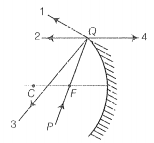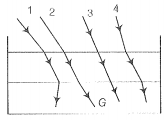The direction of ray of light incident on a concave mirror is shown by PQ while directions in which the ray would travel after reflection is shown by four rays marked 1, 2, 3 and 4 (figure). Which of the four rays correctly shows the direction of reflected ray?

1. 1
2. 2
3. 3
4. 4

The optical density of turpentine is higher than that of water while its mass density is lower. The figure shows a layer of turpentine floating over water in a container. For which one of the four rays incident on turpentine in the given figure, the path shown is correct?

1. 1
2. 2
3. 3
4. 4
A car is moving at a constant speed of 60 kmh-1 on a straight road. Looking at the rearview mirror, the driver finds that the car following him is at a distance of 100 m and is approaching with a speed of 5 kmh-1.
In order to keep track of the car in the rear, the driver begins to glance alternatively at the rear and side mirror of his car after every 2 sec till the other car overtakes, If the two cars were maintaining their speeds, which of the following statement(s) is/are correct?
1. The speed of the car in the rear is 65 kmh-1
2. In the side mirror, the car in the rear would appear to approach with a speed of 5 kmh-1 to the driver of the leading car
3. In the rearview mirror, the speed of the approaching car would appear to decrease as the distance between the cars decreases
4. In the side mirror, the speed of the approaching car would appear to increase as the distance between the cars decreases
There are certain materials developed in laboratories that have a negative refractive index (figure). A ray incident from the air (medium-\(1\)) into such a medium (medium-\(2\)) shall follow a path given by:
| 1. |  |
| 2. |  |
| 3. |  |
| 4. |  |
Consider an extended object immersed in water contained in a plane trough. When seen from close to the edge of the trough, the object looks distorted because:
(a) the apparent depth of the points close to the edge are nearer the surface of the water compared to the points away from the edge
(b) the angle subtended by the image of the object at the eye is smaller than the actual angle subtended by the object in the air
(c) some of the points of the object far away from the edge may not be visible because of total internal reflection
(d) water in a trough acts as a lens and magnifies the object
1. (a, b, c)
2. (a, c, d)
3. (b, c, d)
4. (c, d)
A rectangular block of glass ABCD has a refractive index of 1.6. A pin is placed midway on the face AB as shown in the figure. When observed from the face AD, the pin shall:

1. appear to be near A
2. appear to be near D
3. appear to be at all the centre of AD
4. not be seen at all
Between the primary and secondary rainbows, there is a dark band known as Alexandar's dark band. This is because:
(a) light scattered into this region interfere destructively
(b) there is no light scattered into this region
(c) light is absorbed in this region
(d) angle made at the eye by the scattered rays with respect to the incident light of the sun lies between approximately 42 and 50
1. (a, c)
2. (a, d)
3. (b, d)
4. (c, d)
A magnifying glass is used, as the object to be viewed can be brought closer to the eye than the normal near point. This results in:
(a) a larger angle to be subtended by the object at the eye and hence, viewed in greater detail.
(b) the formation of a virtual erect image.
(c) increase in the field of view.
(d) infinite magnification at the near point.
1. (a, b)
2. (a, c)
3. (b, d)
4. (c, d)
The phenomena involved in the reflection of radiowaves by ionosphere is similar to
1. reflection of light by a plane mirror
2. total internal reflection of light in the air during a mirage
3. dispersion of light by water molecules during the formation of a rainbow
4. scattering of light by the particles of air
The radius of curvature of the curved surface of a plano-convex lens is 20 cm. If the refractive index of the material of the lens be 1.5, it will:
1. act as a convex lens only for the objects that lie on its curved side.
2. act as a concave lens for the objects that lie on its curved side.
3. act as a convex lens irrespective of the side on which the object lies.
4. act as a concave lens irrespective of the side on which the object lies.






